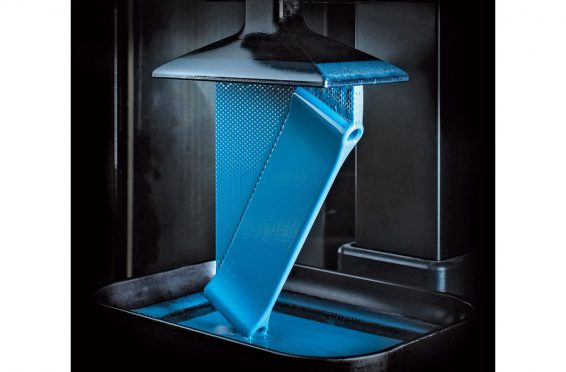In this gleaming lab in Redwood City, Calif., the first thing you notice is the burnt smell in the air. The next thing you notice is the whirring noise, from the machinery at the center of the lab cleaning objects pulled from humming rows of 5-foot-long cylindrical printers. They’re turning sludgy trays of gooey resin into caramel-colored shoe soles, valves, and prototype knee replacements.
This is Carbon, the first company in the $4 billion 3D-printing industry to offer a serious—and seriously fast—alternative to conventional injection molds. Using new materials, hardware, and software, Carbon’s printer, the M1, fires UV light at its syrupy resins to produce prototypes and production parts that can be more bouncy, stiff, tough, or heat-resistant than rival products, printing at speeds competitors can’t match. Co-founder and Chief Executive Officer Joseph DeSimone gets a little flowery when the knees come out. “We don’t print,” he says. “We grow.”
Carbon has raised more than $140 million in venture funding, 10-fold the typical 3D-printing success story, from the likes of Google Ventures and Sequoia Capital. Instead of targeting home hobbyists like MakerBot Industries and Formlabs do, Carbon has teamed up with 15 big paying customers, including Johnson & Johnson, Ford, BMW, and Eastman Kodak. Its processes haven’t been around long enough to demonstrate their durability, but early clients say they’re happy with the medical devices, auto parts, and other equipment they’ve printed with Carbon’s machines. As of April 1, Carbon is making the M1 available to other businesses as part of a yearly subscription program.

The M1 uses a projector to precisely shape the UV light it focuses on polymer gunk, hardening it into solid materials the machine then extracts from the liquid goo. The company says its approach is as much as 100 times faster than those used by rivals, depending on the object’s complexity. DeSimone says the software has a lot to do with that. Every day, each Carbon printer generates 1 million data points, precisely tracking the zaps of the UV light, the movement of the printed object, the rate of the printing, and so on. One customer was alerted to a rash of errors based on a change in room temperature.
Jason Lopes is the lead systems engineer at special effects studio Legacy Effects, which uses 11 kinds of 3D printers. “By default, I’m going to the Carbon machine first,” he says. In three hours, the Carbon prints body armor props that take other machines more than four times as long. Ellen Lee, Ford’s technical head of 3D-printing research, says Carbon’s advantage is the diversity of its plastics, which allows her team to make an especially wide range of models and prototypes from a single printer.
Chip Gear, founder of an industrial manufacturing firm called Technology House, has been using a beta version of the Carbon printer for six months. It has cut printing time for a radio-frequency connector from 12 hours to 40 minutes, and printing eight at once takes just 43 minutes total, says Gear, adding that he bought a second printer in March and is talking with his chief financial officer about ways he can afford more. “I’m trying to find out how many they can let me have this year,” he says.
DeSimone and Alex Ermoshkin, Carbon’s co-founder and chief technology officer, began developing their printer technology in 2013. DeSimone is a chemistry professor at North Carolina State University and the University of North Carolina at Chapel Hill, where he and Ermoshkin worked together. They noticed most 3D-printing companies were trying to print items one layer at a time and bet they could improve the process with a continuous building technique. That year, Ermoshkin built the first prototype printer with his teenage son. By the end of 2013, Sequoia had led Carbon’s first round of funding, totaling $11 million.
Sequoia partner Jim Goetz says the co-founders have laid to rest any worries that Carbon’s early prototype wouldn’t translate into commercial production. The next test will be getting a wider group of customers to pay for it. Carbon charges $40,000 a year to rent one of its printers and get software updates, plus an installation fee of $10,000 and $79 to $399 for every fifth of a gallon of liquid plastic. The company says it isn’t profitable and declined to disclose revenue. DeSimone says he also wants to create an online marketplace where other chemists can sell their own materials for its printers.
Industry analysts warn that Carbon has yet to prove its light-forged plastics wear well. The properties of the plastics “tend to degrade over time, which is why they’re not used for the manufacturing of most products that use plastics,” says Terry Wohlers, president of consulting firm Wohlers Associates. Carbon’s method of printing could hurt the stability and strength of its final products, says Joe Kempton, an analyst with Canalys.
Carbon’s vice president for materials, Jason Rolland, says the company runs industry-standard tests and its materials “look great out to at least six months.” DeSimone says his unique processes help, not hurt, the finished product, especially the way Carbon mixes its plastics from distinct components just before printing. This makes them stronger, he says, because they finish binding together after they’ve been hit with the UV light.
Early users Lopes and Gear say they haven’t had any trouble yet. Lopes says the materials from Carbon hold up “10 times better” than those from others. None of his customers, he says, has come back with any broken parts.

